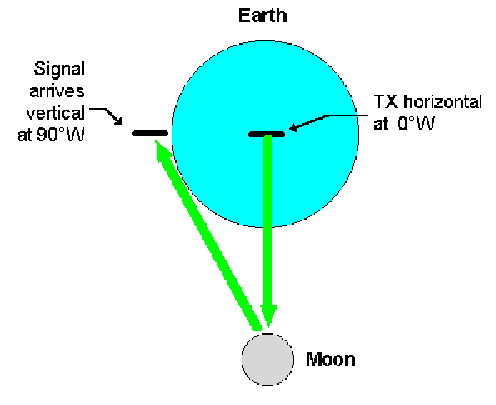Polarization and "One-way" EME Propagation
Paris 432MHz and Above EME Conference, 1998
|
CONTENTS
1. Polarization Problems |
Polarization ProblemsOn 432MHz and below, we all use linear polarization for EME. Yagi stations use the same polarization that we use for other kinds of VHF/UHF DX, which is usually horizontal. A big problem with VHF/UHF EME is that the transmitted polarization is usually rotated before it reaches the receiving station, so there can be very large losses in signal strength. Remember also that EME signals are always close to the noise, with rapid fading, so even a 1dB loss is noticeable.  To keep the signal losses below 1dB, the polarization error must be less than about ±(20-30)°. The good news is that the signal loss within the ±20° region is very small. Geometric Rotation (or Spatial Polarization)If the transmitting and receiving stations are on two different continents, there will almost always be polarization rotation between them, because of their relative positions on the Earth. This is called geometric rotation (or spatial polarization).
Geometric rotation also depends on the moon's position, so it varies with time on each moon pass. The graph below shows how geometric rotation can typically change, for two stations with a 6-hour local time difference.  See how the angle of geometric rotation changes from +45°, up to almost +90°, and then down again through +45°, ending at almost 0° when the moon is setting at the Easterly station. Something like this happens on every moon pass. Faraday RotationFaraday rotation occurs when a linearly polarized signal passes through the ionosphere. When the electromagnetic wave interacts with the charged particles and the Earth's magnetic field, its plane of polarization is rotated. When the rotated signal has been reflected back from the moon and re-enters the ionosphere, it will be rotated some more in the same direction - Faraday rotation does not cancel out. Faraday rotation can not be predicted in advance: you have to accept whatever it is at the moment! Faraday rotation is proportional to 1/(frequency)², so that when the ionosphere does change, the polarization angle changes 9 times more rapidly at 144MHz than it does at 432MHz. This can have many unfavourable consequences. At 144MHz in unstable conditions, Faraday rotation can change rapidly enough that you can lose a station before the QSO is complete; but when the ionosphere is stable, the polarization at 432MHz can remain 'stuck' at a bad angle for the whole day. In disturbed ionospheric conditions, EME signals can also return to earth with their polarization spread over a wide range of angles. In extreme cases the signal strength is the same at all polarization angles, which means an extra signal loss of up to 3dB, or possibly more if there are other significant losses in the ionosphere (this is still under discussion!). |
|
CONTENTS 1. Polarization Problems 2. Geometric Rotation + Faraday Rotation = Trouble! 3.What Happens on the Air
|
Geometric Rotation + Faraday Rotation = Trouble!N1BUG has clearly identified that the real problem is not either geometric
rotation or Faraday rotation on its own - the problem is the interaction
of the two effects. Key to table below:
|
|
CONTENTS 1. Polarization Problems 2. Geometric Rotation + Faraday Rotation = Trouble! 3.What Happens on the Air
|
What Happens On The AirThe table above identifies five different cases:
N1BUG has confirmed this by analysis of EME logs from many stations; he found that two horizontally-polarized stations are very unlikely to work each other at the times when the geometric rotation between them is close to ±45°. Effects on International RelationsIf you have fixed horizontal polarization, one-way propagation is very real - and very frustrating!Sometimes European stations can hear US stations calling CQ,
but they never come back to our calls... they just keep on calling CQ because
replies from Europe are arriving vertically polarized. After several hours of one-way propagation, it becomes very easy to imagine that the guys "over there" have deaf receivers... are running too much power... don't want to work us... are not really serious about EME... none of which is actually true!
|
|
CONTENTS
1. Polarization Problems 2. Geometric Rotation + Faraday Rotation = Trouble! 3.What Happens on the Air |
Back to GM3SEK's Amateur Radio Technical Notebook |
Updated
15 June 2007
Page © 1999-2001 IFWtech.


